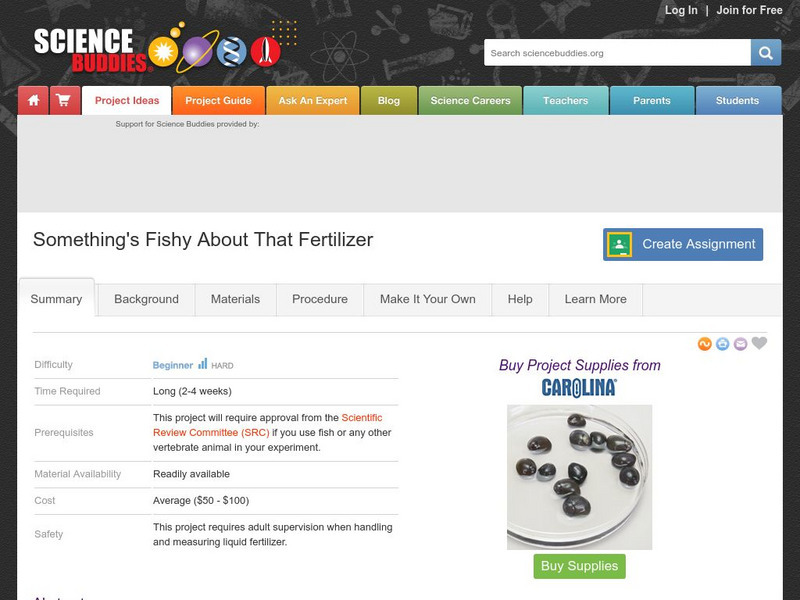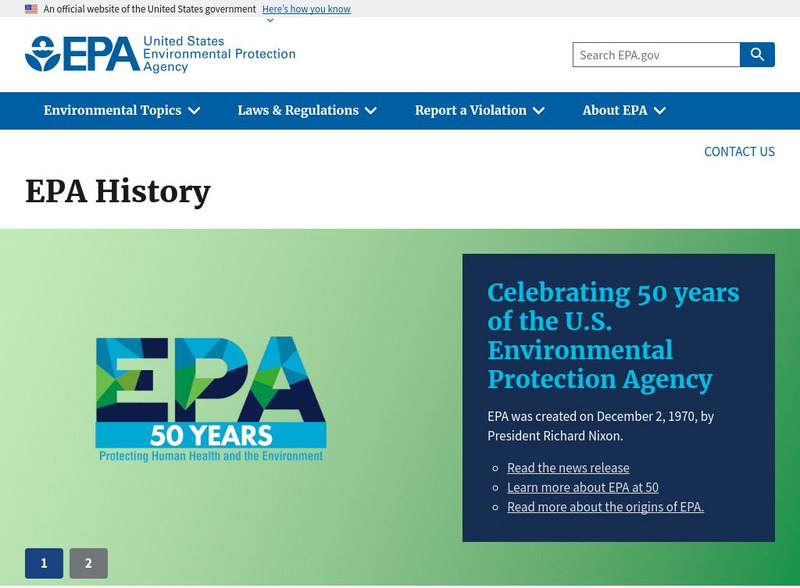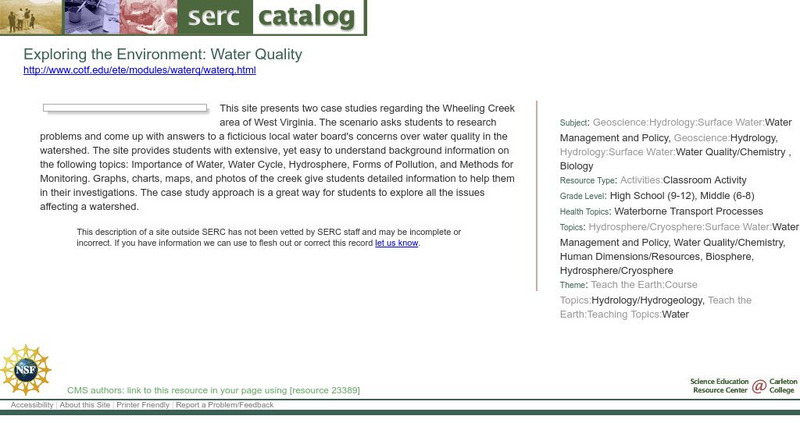Curated OER
How Much Azatrine?
Students understand the connections among people, places, and environments in the local school and community, Kansas and its surrounding states, the U.S. and its region, and the world.
Curated OER
Clean Kansas Water
Students gain an understanding of ways we can be responsible custodians of our water supply. Students explore the governor's clean water initiative involving the Lower Kansas/Republican river basin and the pollutants present there.
Curated OER
Cool, Clear Water - Or Is It?
Students use a problem solving method to offer a solution to one of the water quality problems within the Kansas Lower Republican River Basin. Groups research a problem area, then produce a skit, poem, song or story to illustrate the...
Curated OER
It's Not My Problem!
Students examine how rivers flow through the country to sea level. Students study how upstream pollution effects the water and people downstream.
Curated OER
The Chemistry of Water / Industrial Waste at My High School
Students gain factual knowledge of the nature of industrial waste at on their school site. They gain process knowledge of the laboratory techniques and collection procedures for wastewater samples.
Curated OER
Pollution Solutions: Questions of Quality
Students investigate variations in water quality.
Curated OER
The Berenstain Bears Don't Pollute (Anymore)
Students listen to the story, The Berenstain Bears Don't Pollute (Anymore). They create a Venn Diagram comparing it with the story, The Lorax. Then students plan ways to become advocates for recycling.
Curated OER
What We As Students Can Do To Save Our World
Students investigate air and water pollution, and the conservation of natural resources.
Curated OER
Junior Engineering Surface Water
Pupils experience the effects of pollution and erosion on a model of a watershed and explore ways to change the outcome.
Curated OER
Finding and Measuring What You Can't See
Students determine how scientists measure pollutants in food and the environment. Students discover how scientists remove one material based on its physical properties. Students figure out how much of a pollutant is present after...
Curated OER
Reduce and Reuse
Young scholars conduct a lunch waste audit by recording each item they throw away at lunch. They graph class lunch waste. They use this information to devise a plan of action to reduce lunch waste. There is also an activity to make paper.
Curated OER
Back to the Earth
Students conduct an experiment in which they bury four objects (apple, lettuce, plastic and styrofoam) in the ground and come back to observe them a month later. They consider what biodegrades and how it affects our planet.
Curated OER
Recycle
Students determine the weight of paper waste generated by the class. They brainstorm ways to reduce and recycle. They make their own paper to demonstrate recycling. This lesson plan is very effective in demonstrating how recycling works.
Curated OER
Away with Waste!
Students read and analyze the story Away on the Bay as a springboard to discuss water pollution. They may look into ways in which water can be cleaned and a watershed restored.
Curated OER
Litter Detectives
Students develop a positive attitude against littering by creating solutions to help reduce littering.
Curated OER
the New Explorers:Into the Depths
Students explore the self preservation mechanism that is inherent in the Great Lakes. They examine how scientists are studying Great Lakes, and what their predictions are for these national treasures.
Curated OER
Litter Recognition
Students identify litter, and discuss what to do with it. They analyze people's response to litter. Some people may ignore it, while others may pick it up. They observe student behavior as part of an experiment.
Library of Congress
Loc: American Memory: Evolution of Conservation Movement
American Memory site documents the historical formation of the movement to conserve and protect America's natural heritage. Browse through literature, books, pamphlets, government documents, and manuscripts drawn from the collections of...
US Environmental Protection Agency
Epa: Envirofacts Data Warehouse
Using zip codes, this site allows students to locate businesses in their communities that are producing wastes.
Science Buddies
Science Buddies: Something's Fishy About That Fertilizer
Did you know that when you use fertilizer in your garden, it can eventually reach a lake, stream, or pond? There are many different chemicals present in fertilizers. Learn how they affect the aquatic organisms in the ecosystem within...
Science Buddies
Science Buddies: Heavy Metals and Aquatic Environments
You might know that lead can be toxic, and that you can get lead poisoning from eating or inhaling old paint dust. Lead is called a heavy metal, and there are other sources of heavy metals that can be toxic, too. Silver, copper, mercury,...
US Environmental Protection Agency
Epa: History of the Epa
A complete history of the U.S. Environmental Protection Agency including a timeline, publications, biographies of administrators, origins of the Agency, and photographs.
Science Education Resource Center at Carleton College
Serc: Investigating Ponds and Streams: How Clean Is Our Water?
In this field lab, students investigate the differences in three city ponds. Students will compare pond life, temperature, pH, Ammonia, dissolved oxygen, and Nitrate. The student use the pond sheets (Flinn Scientific Catalog 2007) to...
Science Education Resource Center at Carleton College
Serc: Exploring the Environment: Water Quality
A project based scenario where students research problems and come up with answers to a local water board's concerns over water quality in the watershed. Background information is accessible for the following topics: importance of water,...























